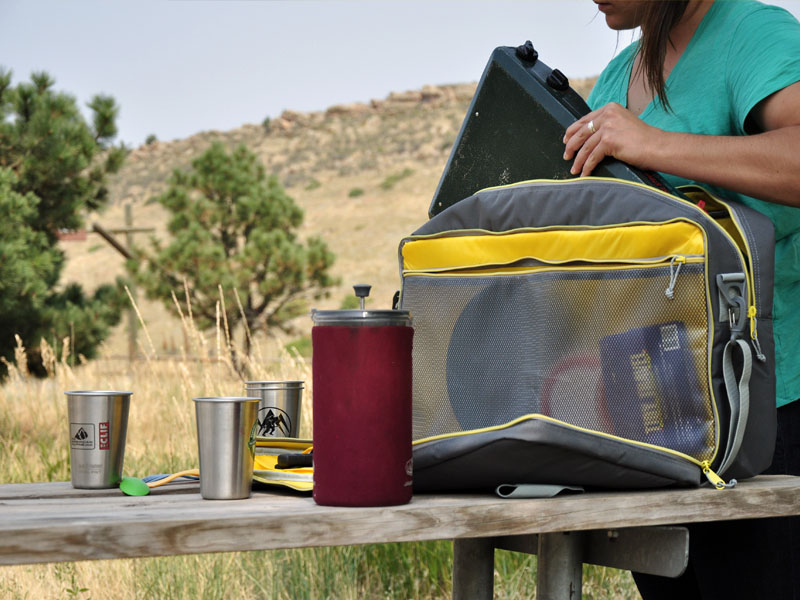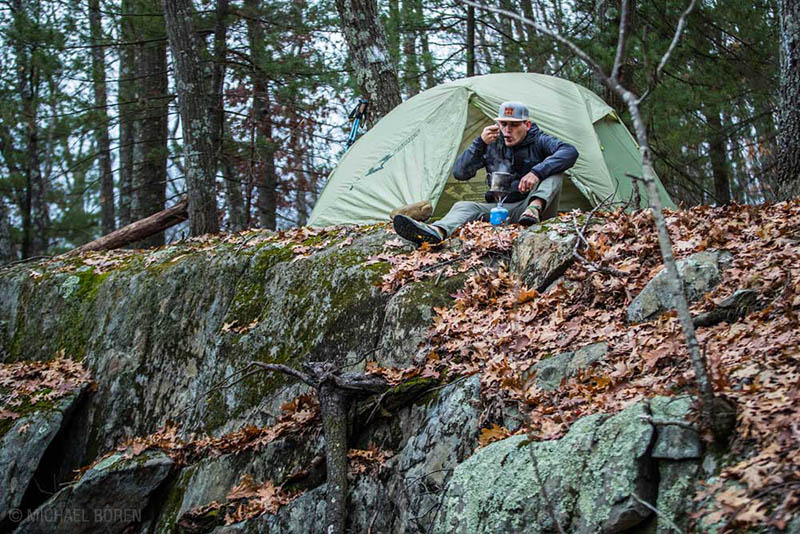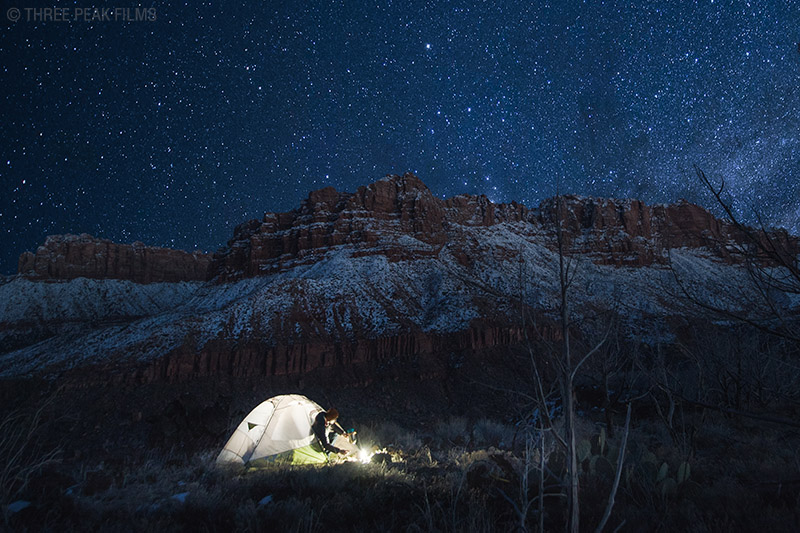Food tastes better in the outdoors… we’re pretty sure it’s science. But no matter how delicious your favorite freeze-dried meal is, or how much you swear by tortillas and peanut butter, trying something new never hurts.
It’s easy to enhance backcountry meals without much extra effort. Whether you’re car camping, out for a backcountry weekend, or in it for the long haul, here are a few ways to elevate your food game during your next trip.
1. Car Camping
The sky’s the limit regarding weight/packability when car camping. Get a good cooler (and some good beers to go with it). Unless you’re going for a week at a time, consider the Cooloir Series, which will give you up to 72 hours of cold storage when packed appropriately.
Don’t forget to bring a spare fuel canister, and stash a few extra garbage bags to pack out waste.
Prep each meal as much as possible
Prepping meals at home helps eliminate food waste to pack out, keeps the campsite organized, and saves time you’re better off enjoying in the great outdoors. Prepping can include pre-scrambling eggs in a tupperware instead of packing the whole carton, slicing and portioning veggies, and throwing seasoning on your food while you have your whole spice rack in front of you.
Adding protein saves even the most boring meal
Add protein to everything, and cook it ahead of time if you can. Not only does pre-cooking save the mess of packing around raw chicken, but it lets you portion and plan better for meals. Adding packaged meat, like tuna or chicken packets, works wonders for generic carb-heavy dinners. Bacon bits on your wrap is a surprisingly delightful addition for lunchtime fuel, and those bacon bits fit in nicely with your morning scramble as well.
Make This: Pesto Pasta with Chicken
At Home:
Season and cook two chicken breasts, cut into chunks, and tuck into your cooler where it’ll stay chilled. Pack a box of pasta, one package sundried tomatoes, and one package dried mushrooms
At Camp:
Bring water to a boil, add pasta, sundried tomatoes, and mushrooms. Cook it. Stir in chicken and pesto. Eat the heck out of it.

Stay Organized
It’s easy to toss everything in the car and deal with the mess once you’re settled back home, but who has time for that? Stash your stove, fuel, utensils, plates, cups, and camp kitchen essentials in an organized storage system like the Hot Box Hauler. It’ll save you prep and clean-up time so that you can focus on the good stuff.
2. Overnight / Weekend Trips

An overnight trip isn’t long enough to worry too much about food weight, but you still aren’t packing cans of refried beans. Trail recipes are fun to experiment with, and you can plan ahead and bring extra ingredients to have something to look forward to at camp.
Season the heck out of generic meals
Mixing up another Alfredo Pasta Side? Spice it up. Tic-tac boxes make terrific portable spice containers—bring a few staples (garlic powder, paprika, cumin) or create your own blends at home and pack your favorites. Adding a cajun or italian spice blend to couscous or pasta brings it up a few flavor notches while hardly adding any weight to your food bag. Packets of soy sauce, mini bottle of Tabasco, and even a travel-size salt/pepper shaker make a huge difference when you’re craving flavor.
Drink your breakfast
You need fuel for the morning miles, but sometimes the desire for another crumbling PopTart or gummy oatmeal packet isn’t there. Enter Carnation Instant Breakfast. Two packets shaken in a liter of water = quick and easy calories. Feeling fancy? Toss an instant coffee packet in the bottle as well. This is a dirtbag mocha and it tastes better than it sounds.
Make This: Overly Indulgent Breakfast Bag
At Home:
In a Ziplock: Mix one cup of your favorite granola with a handful of freeze-dried fruit, slivered almonds, and dried cranberries. Add ½ cup powdered milk (or protein powder for an extra boost) and zip ‘er up tight.
On Trail:
Wake up, take in the view, add enough water to rehydrate the milk, shake it up, and enjoy a surprisingly fancy breakfast-bowl-in-a-bag.
3. Long-Distance Hiking

This is all about the weight-to-calorie ratio. When you’re packing food for up to a week, or planning resupply boxes for a thru-hike, you want to keep your food weight down while your calories sufficient to fuel long miles with a heavy pack. We don’t differentiate as much between extended trips (1-2 weeks) and thru-hikes (3-6 months) because most hikers won’t be out much longer than a 7-9 days without resupplying.
Stoveless? Try cold-soaking couscous
Many long-distance hikers swear by their cold food. It saves the weight of a cookset and fuel, and the effort of washing dishes and gathering extra water. Couscous can be cold-soaked in a Ziplock bag (allow 30 minutes to fully soften) and devoured right on the spot.
Add olive oil… to everything
A thru-hiker can burn up to 10,000 calories a day, so sneaking calories without extra bulk is important to keep energy high and chewing effort low. Olive oil is a fast, easy, and relatively tasteless way to add extra calories to your meals. Choosing the higher-calorie items, like tuna packed in oil instead of water will also add similar calories without having to eat more.
Resupplying during your hike? Pack out heavy food and eat it the first day
In the battle between weight and calories, fresh foods come out on the losing end, which means you’ll be eating a lot of processed foods during an extended hike. But on resupply days, allow yourself to pack out the heavy things, and eat them on the first day. Thru-hikers often pack out fresh fruit, a pack of deli meat, and sometimes an entire pizza, then eat it during the first day back on trail.
Make This: Low-Cash Lo Mein
Dig a Ramen packet, a handful of beef jerky, and a soy sauce packet out of your dilapidated food bag.
Mix it. Cook it. Enjoy it. The whole thing weighs several ounces at most and is an easy way to make your sad instant noodles more palatable.
Originally written by RootsRated.
I love the hacks for weekend and backpacking trips! Another thing that works well for spices if you don’t need much is to put them into straws and seal the ends with a lighter. Pop them open like pixie sticks and they weigh next to nothing. I often also stash salt/pepper packets and condiment packs that I grab from restaurants. You can get quite a variety of sauces, dressings, and spices that way!